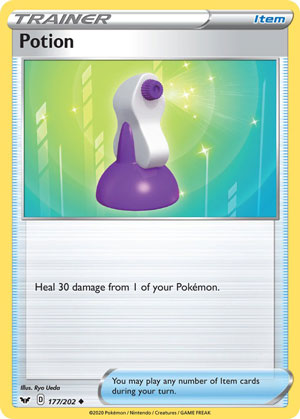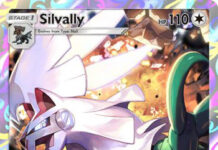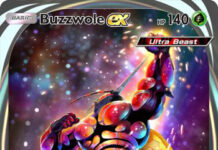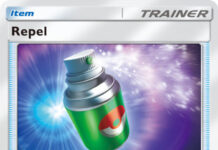
Potion
– Sword & Shield
Date Reviewed:
April 23, 2020
Ratings Summary:
Standard: 2.50
Expanded: 2.50
Limited: 3.75
Theme: 3.75
Legacy:2.50
Ratings are based on a 1 to 5 scale. 1 is horrible. 3 is average. 5 is great.
Reviews Below:
 Vince Today’s Throwback is another one of those cards which debuted all the way back when the Pokémon TCG just began: Potion (Base Set 94/102). Looking at it makes me remember the days of having massive amounts of Potion clogging up my boxes or binders. Sometimes, it might be a good thing to have a couple of those just in case because there may be a period of time where they might not continue to print those. To my surprise of the Pojo.com COTD site, there’s only one review of it more than eight years ago when they had a theme errata week going on. Other further prints were made after Base Set: -Base Set 2 (122/130) Before the errata, Potion heals 20 damage from one of your Pokémon, technically. Some of the pre-errata text had too much unnecessary text. “Remove 2 damage counters from one of your Pokémon. Remove 1 if there’s only 1 damage counter on it.” Damage counters is actually a terminology (which is not the same as just the word “damage”) such that for every damage counter on that Pokémon, that counts as 10 damage. So 2 damage counters mean 20 damage. Potion was also around time where 2-on-2 rules were exerted during the ex series (meaning putting 2 Pokémon on the Active spot instead of 1 while you can only have up to 4 Benched Pokémon instead of five). The rulebook had to make it extremely clear that Potion DOES NOT let you remove 1 damage counter from two of your Pokémon! The errata issued around the time Black & White was released stated this: “Heal 30 damage from 1 of your Pokémon”. Perhaps the reason why the designers would enforce the “heal” terminology is to cease confusion between “damage” and “Damage Counters”. The “damage counter” terminology still exists for when certain attacks, abilities, energy cards, and/or trainer cards lets you place them, and it sticks to being that for every damage counters means an increments of 10 damage. Between the pre-errata and the errata, Potion can be consider to have it’s effect improved, but not by much. Much like those “draw 3” Supporter cards, Potion can serve as a baseline to compare against other healing cards. No doubt, there are lots of healing items and/or healing based abilities which outclasses Potion, but not without giving up something in return, which I’ll list the criteria below. –Cost: Some healing cards makes you give up certain resources before you benefit the healing effect. Hyper Potion is an example, as it forces you to give up 2 Energy attached to one of your Pokémon in order to 120 damage from it. If you can’t meet the cost, you most likely not be able to play a certain card from your hand instead of “failing” to do it. Other cards like Mixed Herbs can sometimes require you to play 2 of them from your hand at the same time to reap the maximum benefit. If you can’t cope with the cost, then these cards aren’t for you. Pokémon Center Lady can be consider as a cost as well, despite healing 60 HP and recovering from all Special Conditions, it uses up your Supporter for the turn, which may or may not be a good thing depending on other Supporters you have on your hand. –Specialization: Some healing cards require a certain type, stage, or even an mechanic of a Pokémon in order to be healed. Great Potion is an example of this, healing 50 damage from your Active Pokémon-GX. Or Gardenia healing 80 damage from 1 of your Pokémon that has any Grass Energies attached to it. Specialized healing cards can be useful in certain decks, but useless in others. –Luck: Some healing cards need a bit of luck in order to benefit from healing effects that would otherwise do nothing. For the most part, the effect text will make you flip coins and you have to land heads in order to work. Cards like Moomoo Milk and Life Herb are unreliable because the RNG might not be in your favor. In the PTCGO, the computer does the coin flip for you, and in IRL it depends on how you flip the coin or how you roll the dice (DON’T think of some supernatural way to land heads every time, it’s not gonna realistically happen). –Aftermath: Some healing cards does heal your Pokémon immediately, but also have a drawback after you healed your Pokémon. Super and Max Potion are some examples, as it heals your Pokémon first, but then discards a certain amount of energies from that Pokémon afterward. Though you might be able to play around such aftermath; if your Pokémon doesn’t have any energy attached, the energy discard is meaningless. If you have Pokémon whose abilities can move energy around, that strategy also plays around that drawback. Abilities that provide multiple attachments can recover from that aftermath. –Ability lock: Some abilities does heal your Pokémon, such as Leafeon-GX and Vaporeon-GX, but because they’re abilities, they can be turned off by Power Plant and/or Expanded Garbodor’s Garbotoxin ability, rendering those abilities useless. Ultimately, even with most of the things that outclass Potion, if it doesn’t shift certain 2HKOs into 3HKOs (kinda like 2HKO plus overkill), then they are no better than Potion. Potion’s healing may be pretty small, but it can still change certain 2HKOs into 3HKOs. I consider Potion to be a good healing card because it doesn’t get affected by any of the criteria mentioned above. It’s the only healing card without a cost, being specialized, that’s guaranteed to happen, no aftermath, and doesn’t deal with ability lock, which is why Potion is used occasionally – even in major tournaments – when other healing alternatives doesn’t fit a certain deck’s needs. It does suffer from item lock and/or Poltergeist style attacks, but you could say the same to other trainer cards; it’s not Potion’s fault. We haven’t even covered the other side of the spectrum in regards to “scooping”. No, not as in forfeiting the match, but to pick up a Pokémon from play and put them into your hand. Those are mostly superior than healing cards since not only it gets rid of all damage from that injured Pokémon (similar to Max Potion), effects that was placed on said Pokémon is also gone. But sometimes, you may get to keep all cards attached to it into your hand like Super Scoop Up, and other times you have to discard those energies and/or Pokémon Tools when you’re scooping, just the Pokémon’s entire evolutionary stages (much like what AZ does). So even scooping isn’t the answer to everything. With Potion appearing in several expansions and several Theme Decks, both compatible and incompatible cards, there’s no shame of using this as Potion is designed to help your Pokémon last longer (unless you feel like using alternative better healing cards with at least one of the criteria mentioned above). Plus you’re stuck using Potion in Theme Decks since the contents of such decks can’t be altered. Ratings: Standard: 3/5 Potion has aged well over the years. As I said before, the reason why I like Potion more than any other healing card is that this card has no drawbacks from using it (besides being an item card), even though it is outclassed by many other healing cards. Even a little bit of healing can soften some attacks (maybe surviving with 10, 20, or 30 HP after you used one Potion), giving you one more turn with your current Pokémon to turn the tables during a match. Those scores may seem too generous, and that’s the best I can give to Potion for what it does. |
 Otaku *Reads Vince’s review* Yes, another tardy Card of the Day from me, dear readers. Vince has thoroughly covered Potion, though I’ll rehash a decent chunk of what he said as I put my own spin on things. Potion dates all the way back to the Base Set, but its most recent printing being Sword & Shield 177/202, still technically the newest set. Things have changed with Potion over the years, but perhaps not as much as one might thing. The only reason Potion has not always been a “Trainer-Item” is because the terminology didn’t exist until the introduction of the Black & White series, I believe with the official release of the Kalos Starter Series Theme Decks. Before that, Potion was a “normal Trainer”, which not only work the same as modern-day Item cards, but have a blanket ruling that states they are Trainer-Items for all intents and purposes. This means, barring outside interference, Potion has and will remain an easy card to play, unless they were to issue an errata to add a cost to it. Potion’s original effect let you remove up to two damage counters from one of your Pokémon but I don’t think it actually did that. The idea was to remove two damage counters if there were two or more damage counters on the Pokémon being targeted, or one if there was only one, and if there were none, you couldn’t use Potion on that Pokémon. This is supported by Potion (EX – Ruby & Sapphire 91/109), and the seven other printings that use its wording, stating just that. Most players knew how Potion was supposed to work, but you had those are easily confused or like to really push what the wording allows a card to do. Pokémon has lasted a long time, and perhaps the two most infamous examples of power creep are rising HP scores and rising damage output in the game, especially when the latter is for lower and lower costs as well. This was half the reason Potion received its last major text change; the other half was that the game’s designers were finally comfortable introducing specific terms for certain game effects, so that they didn’t need so much explanatory text… because you were supposed to know the term from the rule book, and the rule book explained it all. So Potion now heals 30 damage from one of your Pokémon. Given how massive HP scores have become, Potion might be overdue another errata, upping that amount to 40, 50, or maybe even 60. Snorlax VMAX’s 340 HP is nearly three times that of the original printed maximum HP of 120. Speculation aside, the “heal” became a keyword to explain removing damage counters as an act of… well… healing a Pokémon. As opposed to moving it around, it going away because something was bounced to hand, KO’d, discarded from the field, etc. Healing, just like offensive buffs and protective effects, only matters if:
For competitive play, healing 30 damage with an Item is often not enough to actually matter. Even though they cost more or come with bigger drawbacks, healing from Max Potion or Mallow & Lana has a much better chance of keeping something alive and in play longer. The same is true for effects that bounce a Pokémon back to your hand, like AZ or Acerola, or other alternatives to leaving it in play and (likely) to be KO’d. Throughout the history of competitive play, however, there have been times when a clutch Potion has been a worthy inclusion, because healing 30 (or even 20 back in the day) really was a game changer. In the present, Potion is great as a teaching card. Not only is it the simplest form of healing, but healing means your Pokémon might stay in play a bit longer, which gives you more time to become used to using them. This is why, for a novice’s early Standard, Expanded, and Legacy Format decks, Potion still may belong even if it really isn’t the best card to run… not unlike including a card like Hop over Professor’s Research until that player gains a little experience and can handle having to discard their hand before drawing seven cards. It shouldn’t come as a surprise that Potion is a goodcard when you’re participating in a Limited Format event, or duking it out in the PTCGO’s Theme Format. While these can be fun and even educational for experienced players, they’re also designed to help teach new players the game. Potion still isn’t great here; it may not show up at a time when it can matter, and especially when Weakness is a factor, even in the Theme Format healing 30 may not be enough to shift the turn count for KO’s. Definitely include Potion if you pull it in the Limited Format, and try to use it well in Theme. Ratings
I believe Potion has been legal for every Standard Format, though sometimes only barely, due to a last minute reprint. This suggests that the designers consider it something of a staple, at least from the perspective of the card pool. It can be useful for beginners, and on rare occasions for the rest of us, which is good enough to avoid a minimum score. Still, Potion should be scoring a point higher in each of the Formats. If the game’s designers can shift us away from metagame where OHKO’s aren’t so common, and if they finally scale up the healing without introducing an obviously superior alternative, Potion could be an average – but still good – card. |
We would love more volunteers to help us with our Card of the Day reviews. If you want to share your ideas on cards with other fans, feel free to drop us an email. We’d be happy to link back to your blog / YouTube Channel / etc. 😉
Click here to read our Pokémon Card of the Day Archive. We have reviewed more than 3500 Pokemon cards over the last 17+ years!



